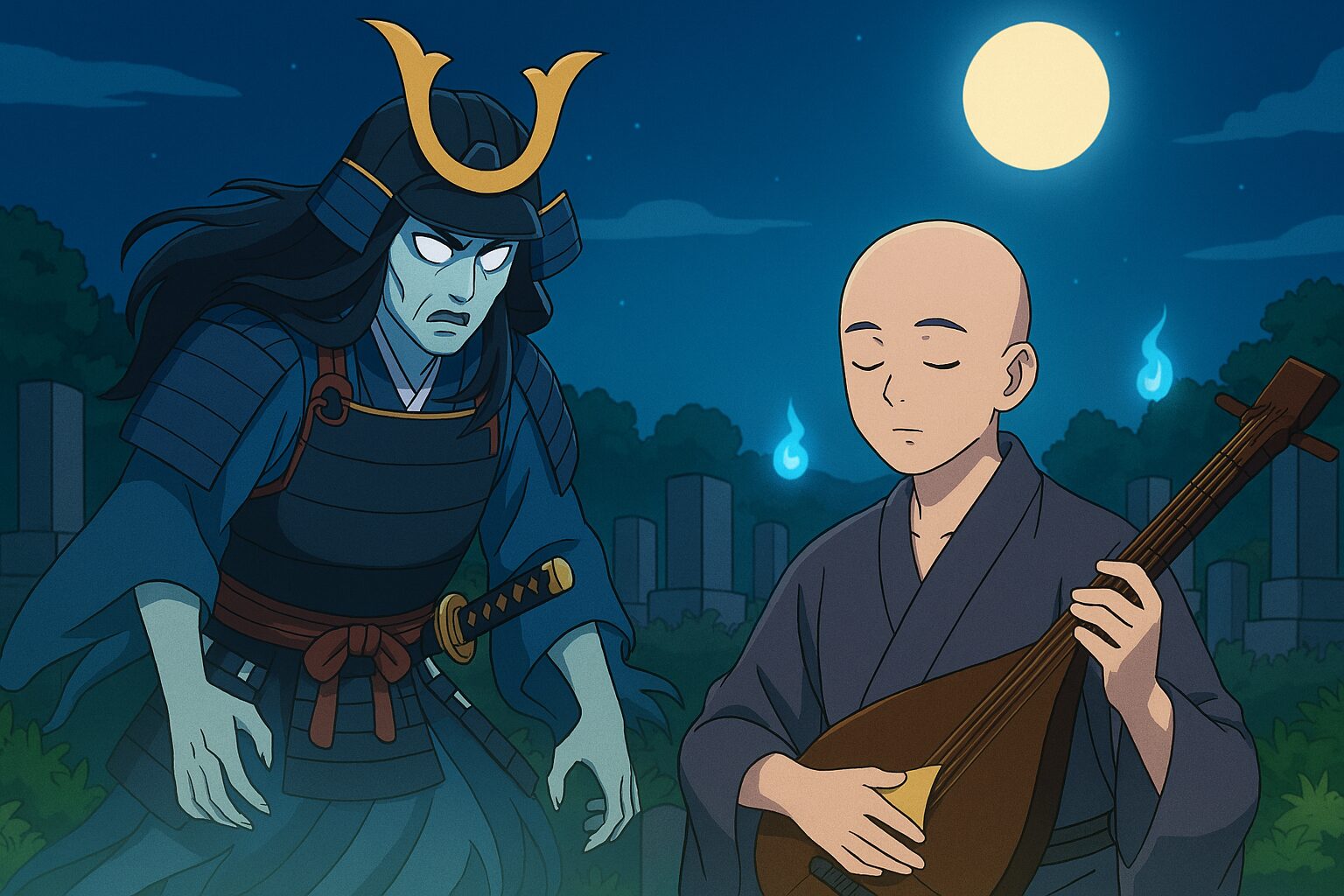👻 Miminashi Hōichi: The Ghostly Tale of a Blind Musician
A Japanese Folktale Explained for International Readers
- Welcome to the World of Japanese Ghost Stories
- 🪷 Historical Background: The Battle of Dan-no-ura
- 🎼 Who Was Hōichi?
- 👁️🗨️ The Strange Occurrence
- 😱 The Tragic Ending
- 📚 Cultural Significance and Lessons
- 🌏 A Message for International Readers
- 🏯 Places to Visit
- ✍️ Conclusion
- はじめに:日本の怪談文化へようこそ
- 🪷 物語の舞台:平家物語と壇ノ浦の戦い
- 🎼 芳一とは誰か?盲目の琵琶法師
- 👁️🗨️ 怪異の始まり:芳一の異変
- 😱 恐怖の結末:耳を持っていかれる芳一
- 📚 物語の教訓と文化的意味
- 🌏 海外読者へのメッセージ
- 🏯 実際に訪れてみたい場所
- ✍️ まとめ
Welcome to the World of Japanese Ghost Stories
Japan has a rich tradition of ghost stories known as kaidan. These tales often feature spirits, supernatural events, and eerie encounters. They are especially popular during summer, when people seek chills to beat the heat.
Among the most famous is the story of Miminashi Hōichi, or “Hōichi the Earless.” This haunting tale blends history, religion, and tragedy into a powerful narrative that continues to captivate audiences worldwide.
🪷 Historical Background: The Battle of Dan-no-ura
The story of Hōichi is deeply connected to the Battle of Dan-no-ura, a decisive naval battle in 1185 between the Genji and Heike clans. It took place in the waters of present-day Shimonoseki, Yamaguchi Prefecture.
The Heike clan was defeated, and many—including the young Emperor Antoku—drowned themselves in the sea. This tragic event is immortalized in the epic Tale of the Heike, which blind musicians known as biwa hōshi would recite to honor the dead.
🎼 Who Was Hōichi?
Hōichi was a blind biwa player renowned for his moving recitations of the Tale of the Heike. His performances were so powerful that they were said to stir the souls of the dead.
One night, Hōichi was summoned by mysterious visitors to perform his music. Unbeknownst to him, his audience was not of this world—they were the ghosts of the Heike warriors who had perished at Dan-no-ura.
👁️🗨️ The Strange Occurrence
Concerned by Hōichi’s nightly disappearances, the temple priest followed him and discovered the truth. To protect Hōichi from the spirits, the priest wrote the sacred Heart Sutra all over his body, rendering him invisible to ghosts.
However, the priest forgot to write the sutra on Hōichi’s ears.
😱 The Tragic Ending
That night, the ghosts returned but could only see Hōichi’s ears. Believing they must take something back to their master, they tore his ears off and vanished.
From that day forward, Hōichi became known as “Miminashi Hōichi”—Hōichi the Earless.
📚 Cultural Significance and Lessons
- Respect for the Dead: Hōichi’s story reflects the importance of honoring those who have passed.
- Buddhist Protection: The Heart Sutra symbolizes spiritual defense against evil.
- Oral Tradition: Biwa players like Hōichi preserved history through storytelling and music.
This tale is not just a ghost story—it’s a window into Japanese beliefs about life, death, and remembrance.
🌏 A Message for International Readers
Miminashi Hōichi was introduced to the West by Lafcadio Hearn, a writer who translated many Japanese ghost stories into English. His work helped bridge cultural gaps and share Japan’s rich folklore with the world.
🏯 Places to Visit
If you ever visit Japan, consider stopping by Akama Shrine in Shimonoseki. It commemorates the souls lost in the Battle of Dan-no-ura and features a statue of Hōichi himself.
✍️ Conclusion
Miminashi Hōichi is more than a chilling tale—it’s a cultural treasure that reveals the depth of Japanese history, religion, and storytelling. Through this story, we learn about reverence, protection, and the power of words and music to transcend life and death.
Whether you’re a fan of ghost stories or curious about Japanese culture, Hōichi’s tale is a hauntingly beautiful place to begin.
© 2025 Japanese Folktale Series Blog
👻 耳なし芳一:幽霊と琵琶法師の物語
海外読者のための日本怪談ガイド
はじめに:日本の怪談文化へようこそ
日本には、古くから語り継がれてきた「怪談」というジャンルの物語があります。幽霊や妖怪、不可思議な出来事を描いた物語で、夏になるとテレビ番組や舞台、書籍などでよく取り上げられます。
その中でも特に有名なのが「耳なし芳一」という話です。この記事では、日本のことをあまり知らない海外の読者にもわかりやすく、この物語とその背景について紹介します。
🪷 物語の舞台:平家物語と壇ノ浦の戦い
「耳なし芳一」は、鎌倉時代の歴史的事件「壇ノ浦の戦い」に深く関係しています。壇ノ浦は、現在の山口県下関市にある海峡で、源氏と平家という二つの武士団が最後の戦いを繰り広げた場所です。
この戦いで平家は敗れ、幼い安徳天皇を含む多くの人々が海に身を投げて命を落としました。その悲劇は「平家物語」という叙事詩に描かれています。
🎼 芳一とは誰か?盲目の琵琶法師
芳一は、目が見えない琵琶法師で、平家物語を語ることに長けていました。彼の語りは非常に美しく、聞く者の心を揺さぶるほどだったといわれています。
ある日、芳一は夜中に一人で平家物語を語るように頼まれます。相手はなんと、壇ノ浦で亡くなった平家の亡霊たちだったのです。
👁️🗨️ 怪異の始まり:芳一の異変
芳一が夜中に姿を消すことに気づいた寺の住職は、彼の後をつけて真相を知ります。芳一が幽霊たちに語り聞かせていることを知った住職は、芳一の身を守るために「般若心経」という仏教の経文を彼の体中に書きます。
しかし、住職はうっかり芳一の耳にだけ経文を書くのを忘れてしまいます。
😱 恐怖の結末:耳を持っていかれる芳一
その夜、幽霊たちは芳一の姿が見えなくなったことに驚きます。彼らには経文が見えないため、芳一の体は見えなくなっていたのです。しかし、耳だけは見えていたため、幽霊たちは「耳だけでも持ち帰ろう」と言って、芳一の耳を引きちぎってしまいます。
こうして芳一は「耳なし芳一」と呼ばれるようになったのです。
📚 物語の教訓と文化的意味
- 死者への敬意
- 仏教の力と信仰
- 語り部の役割と文化継承
この物語は、単なる怪談ではなく、日本人の死生観や宗教観を反映した文化的な物語です。
🌏 海外読者へのメッセージ
「耳なし芳一」は、アメリカの作家ラフカディオ・ハーンによって英語に翻訳され、世界中に知られるようになりました。彼は日本の怪談を多数紹介し、日本文化の魅力を海外に広めた人物です。
🏯 実際に訪れてみたい場所
耳なし芳一の物語に関連する場所として、山口県下関市の「赤間神宮」があります。ここには壇ノ浦の戦いで亡くなった人々を祀る施設があり、芳一の像も建てられています。
✍️ まとめ
「耳なし芳一」は、幽霊の話でありながら、日本の歴史、宗教、芸術、語りの文化を知るための素晴らしい入り口です。怖いだけでなく、深い意味と美しさを持つこの物語を、ぜひ多くの人に知ってもらいたいと思います。
© 2025 日本怪談シリーズブログ



コメント